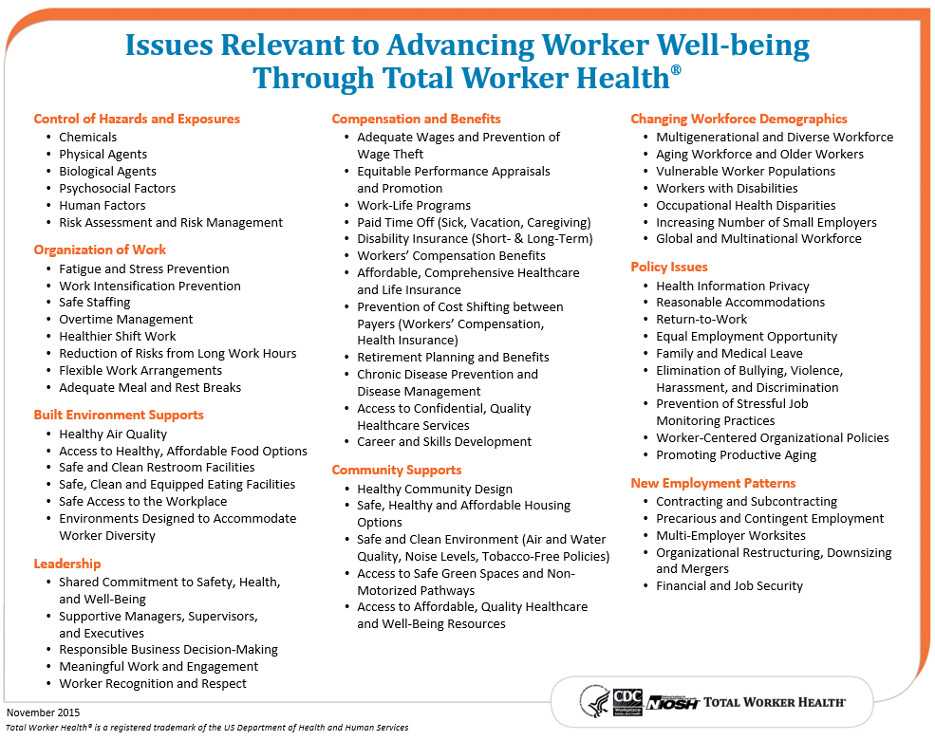TOTAL WORKER HEALTH

What is Total Worker Health®?
Total Worker Health® is defined as policies, programs, and practices that integrate protection from work-related safety and health hazards with promotion of injury and illness prevention efforts to advance worker well-being.
Traditional occupational safety and health protection programs have primarily concentrated on ensuring that work is safe and that workers are protected from the harms that arise from work itself. Total Worker Health (TWH) builds on this approach through the recognition that work is a social determinant of health; job-related factors such as wages, hours of work, workload and stress levels, interactions with coworkers and supervisors, access to paid leave, and health-promoting workplaces all can have an important impact on the well-being of workers, their families, and their communities.
In June 2011, NIOSH launched the Total Worker Health (TWH) Program as an evolution of the NIOSH Steps to a Healthier U.S. Workforce and the NIOSH WorkLife Initiatives. The TWH Program supports the development and adoption of ground-breaking research and best practices of approaches that emphasize the opportunities to sustain and improve worker safety and health through a primary focus on the workplace. The TWH approach integrates workplace interventions that protect safety and health with activities that advance the overall well-being of workers. Establishing policies, programs, and practices within the workplace that focus on advancing the safety, health and well-being of the workforce may be helpful for individuals, their families, communities, employers and the economy as a whole. The original scientific rationale for expanding research on the benefits of integrated programs to improve worker health and workplace safety was published in 2012 in a research compendium of three seminal papers on the science and practice of integrating health protection and health promotion, The NIOSH Total Worker Health® Program: Seminal Research Papers 2012.
Benefits for Workers
TWH explores opportunities to both protect workers from hazards and advance their health and well-being by targeting the conditions of work. Scientific evidence now supports what many safety and health professionals, as well as workers themselves, have long suspected—that risk factors in the workplace can contribute to health problems previously considered unrelated to work. For example, there are work-related risk factors for abnormal weight fluctuations 1, 2, sleep disorders3, cardiovascular disease4, depression5, 6, 7, and other health conditions. In recognition of these relationships, some newly observed and others based on established scientific evidence, the TWH approach focuses on how environmental and organizational factors related to work can diminish or enhance overall worker health.
Benefits for Employers and Communities
Research on the TWH approach provides the needed scientific evidence to help businesses and communities reduce the impact and cost of injuries and illness, thereby helping to control healthcare costs and disruption to family and community life. As work and work environments change to meet the demands of 21st century economies, comprehensive approaches are needed to address complex realities. TWH is a comprehensive approach that looks for new solutions to long-standing issues related to worker safety and health. The TWH approach provides a pathway to improve worker creativity, innovation, and productivity by creating work and work environments that are safe and health-enhancing.
Unique expertise of NIOSH
For over 40 years, NIOSH has been a national and global leader in research that protects the safety and health of workers and promotes productive workplaces. NIOSH-funded research provides the knowledge needed to understand the challenges workers and employers encounter in the workplace and the practical solutions needed to meet those challenges so workers remain safe and employers retain a productive workforce. Conceived to address the 21st century safety and health challenges in the workplace, TWH is one of the newest NIOSH research portfolios. While our understanding of integrated approaches to worker safety, health, and well-being has grown over the past decade, there are still significant gaps in our knowledge.
To build the scientific evidence needed to craft new solutions for complex problems, some new and some longstanding, NIOSH funds six Centers of Excellence for Total Worker Health. These Centers are hubs of TWH-related research and practice activity and they provide new knowledge and new approaches for addressing some of the toughest problems faced by employers today. By conducting research on integrated approaches to worker safety, health and well-being, the contributions of these Centers are unique and robust.
The NIOSH infrastructure for funding research is rigorous and only proposals of the highest quality and programmatic relevance are accepted for funding. As part of the country’s leading public health agency, NIOSH is the only federal agency mandated to protect worker safety and health. TWH is an innovative approach to fulfilling that mandate.
Keeping Workers Safe is Fundamental to Total Worker Health
With the Congressional mandate “to assure so far as possible every man and woman in the Nation safe and healthful working conditions and to preserve our human resources, ” keeping workers safe is the foundation upon which Total Worker Health is achieved. Employers and employer- worker partnerships wishing to establish effective workplace programs that sustain and improve worker health must first consider the foundational principles of occupational safety and health that are dedicated to keeping workplaces safe and workers protected. First-dollar investments must address hazardous working conditions. Only after these safeguards are in place can organizations move their workforce toward a state of total worker health. Employers who opt for wellness programs in the absence of adequate workplace safety and health protections are not applying the principles of Total Worker Health.
Published in 2016, the workbook, Fundamentals of Total Worker Health® Approaches: Essential Elements for Advancing Worker Safety, Health, and Well-being, prioritizes a hazard-free work environment for all workers and applies a modern prevention approach—consistent with traditional occupational safety and health prevention principles—that recognizes that job-related factors can have an important impact on the well-being of workers, their families, and their communities.
Issues Relevant to Advancing Worker Well-being Through Total Worker Health
The following graphic “Issues Relevant to Advancing Worker Well-being Through Total Worker Health®” illustrates a wide-ranging list of issues that are relevant to advancing worker well-being through a Total Worker Health approach. The list of issues relevant to Total Worker Health was revised, retitled and published in November 2015 with input from stakeholders. This updated list reflects an expanded focus for TWH that recognizes that new technologies, new working conditions, and new emerging forms of employment present new risks to worker safety, health and well-being. Understanding and reducing those risks are important elements of TWH. Additionally, this expanded focus recognizes that there are linkages between health conditions that may not arise from work but that can be adversely affected by work. A Total Worker Health approach advocates for the integration of all organizational policies, programs and practices that contribute to worker safety, health and well-being, including those relevant to the control of hazards and exposures, the organization of work, compensation and benefits, built environment supports, leadership, changing workforce demographics, policy issues, and community supports.”

Here are examples of TWH approaches as applied to specific workplace challenges:
- To prevent risk of musculoskeletal disorders, consider:
- Reorganizing or redesigning how individuals do their work;
- Providing ergonomic consultations; and
- Providing education on arthritis self-management strategies.
- To reduce work-related stress, consider:
- Implementing organizational and management policies that give workers more flexibility and control over their schedules;
- Providing training for supervisors on approaches to reducing stressful working conditions; and
- Providing skill-building interventions on stress reduction for all workers.
For more about Total Worker Health, visit our Frequently Asked Questions page.
- Page last reviewed: November 6, 2015
- Page last updated: July 21, 2017
- Content source:
- National Institute for Occupational Safety and Health Office of the Director
TOTAL WORKER HEALTH ® is a registered trademark of the US Department of Health and Human Services



 ShareCompartir
ShareCompartir